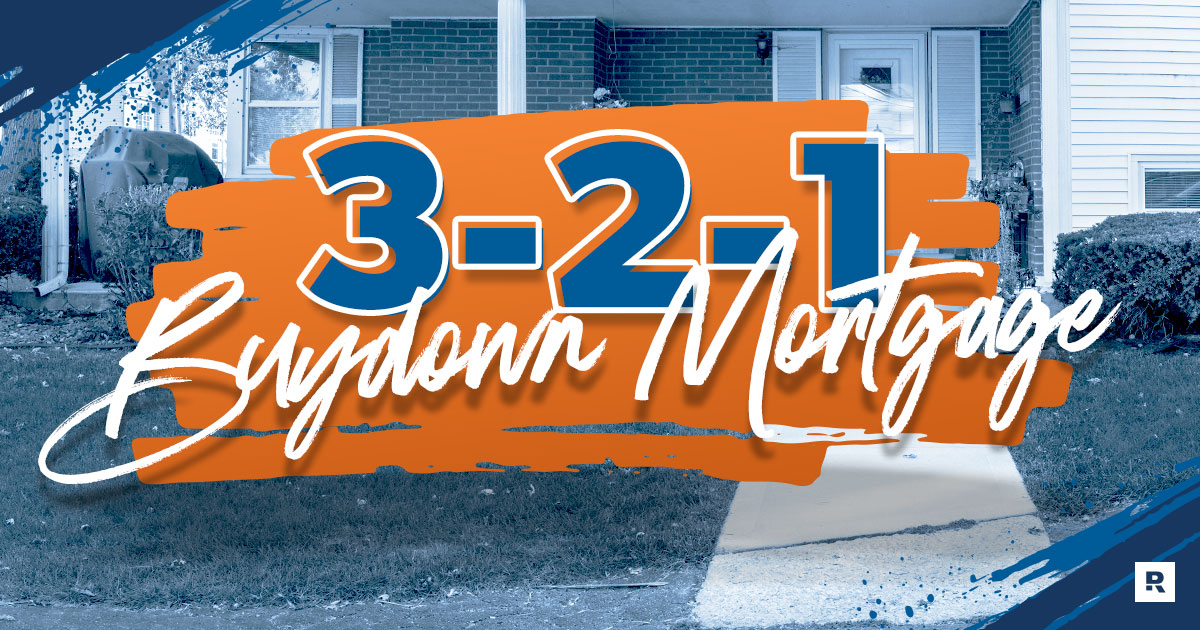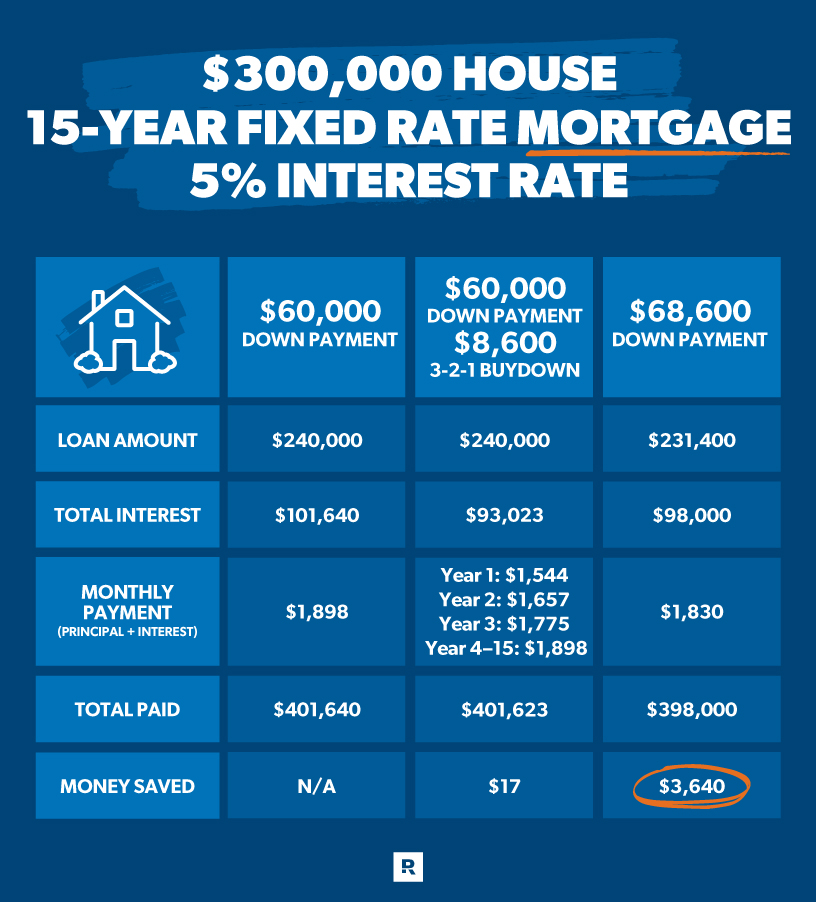
This whole home-buying thing has gotten just a little more difficult over the last few years. House prices have gone up a ton, and mortgage interest rates have shot higher than the Empire State Building.
So, to help buyers deal with those challenges, some mortgage lenders and sellers have gotten a little creative and started pushing something called a 3-2-1 mortgage buydown. While 3-2-1 buydowns aren’t new, they have gotten a little more popular lately.
If your lender, seller or builder is offering you one of these buydowns, you probably have two questions on your mind: What exactly are 3-2-1 mortgage buydowns, and are they a good idea?
Let’s break it all down! We’ll talk about what 3-2-1 buydowns are all about, how much they cost, who pays for them, and—most importantly—whether they’re a good idea. That way, you’ll be able to make the best decision for you and your family when you buy a house.
What Is a 3-2-1 Mortgage Buydown?
A 3-2-1 mortgage buydown is a way for home buyers to reduce their interest rate in the first three years of their mortgage. In exchange for an up-front fee (paid in cash), a lender will lower the interest rate on your mortgage by 3% in the first year, 2% in the second year, and 1% in the third year—that’s where the 3-2-1 part comes from.
Once those three years are up, your mortgage will return to the standard interest rate you agreed on when the mortgage was finalized. If you use a fixed-rate loan (the only type of mortgage you should use, by the way), you’ll keep that interest rate until you pay off your house or refinance.
How Does a 3-2-1 Buydown Work?
Let’s work through an example to see how a 3-2-1 mortgage buydown plays out. For this example, we’ll say you’re buying a $300,000 house on a 15-year fixed-rate loan with a 20% down payment and a 5% interest rate.
If you got a 3-2-1 buydown, here’s what your monthly payments on your mortgage principal and interest would look like:
- Year 1: $1,544 (2% interest)
- Year 2: $1,657 (3% interest)
- Year 3: $1,775 (4% interest)
- Years 4–15: $1,898 (5% interest)
It’s easy as 3-2-1, just like the Jackson 5 said! (Okay, maybe we got that backwards.)
How Much Does a 3-2-1 Buydown Cost?
Lenders offer the lower interest rates you get with a 3-2-1 buydown (or any other type of buydown, like mortgage points) in exchange for a fee you pay in cash when you take out the loan.
How much is the fee? Well, it depends on how big your loan is. That’s because the fee a lender charges for a 3-2-1 mortgage buydown will be almost the same as the amount of interest you’ll save during the three years it’s in effect. So if a 3-2-1 buydown would save you $10,000 over its three-year lifetime, getting it would cost . . . $10,000 (give or take a few bucks).
Who Pays for a 3-2-1 Buydown?
Pretty much anyone involved in the process of buying or selling a home can pay for a 3-2-1 mortgage buydown—including the seller, the buyer or even a builder.
Sometimes, a seller will offer to pay for a 3-2-1 buydown so their listing will have a little icing on the cake. After all, getting a three-year discount on payments is a pretty great perk! Builders will also sometimes pay for 3-2-1 mortgage buydowns to entice buyers to purchase newly built homes in brand new developments.
You can also pay for a 3-2-1 buydown as a buyer when you take out a mortgage with certain lenders.
Get the right mortgage from a trusted lender.
Whether you’re buying or refinancing, you can trust Churchill Mortgage to help you choose the best mortgage with a locked-in rate.
Are 3-2-1 Mortgage Buydowns a Good Idea?
Now you know exactly what 3-2-1 buydowns are all about. But there’s one more very important question we need to discuss: Should you get one? Well, it depends on who’s paying.
Dave Ramsey recommends one mortgage company. This one!
If a seller or builder is paying for it, then a 3-2-1 mortgage buydown is definitely a good idea. In that situation, you’d be getting a discount on your house payments for three years with no extra fees or strings attached. That’s free money! Aka, a really good deal.
But if you have to foot the bill for the buydown, make like Ariana Grande and say, “Thank you, next.”
Why? Because a 3-2-1 mortgage buydown isn’t a very good deal if you’re the one paying for it. It’s not even a discount at that point—all you’re doing when you get a 3-2-1 buydown is prepaying for your mortgage.
Imagine giving a department store $20 so that, later, they’ll offer you a $20 discount on a shirt you want to buy. That would be silly, right? Well, that’s pretty much exactly what’s happening when you pay for a 3-2-1 buydown on your mortgage.
Plus, you’ll save a whole lot more if you put that extra cash toward your down payment instead of a buydown. When you do that, you’ll wind up with less total interest and the money will go toward your equity instead of . . . nothing.
How much more? Let’s crunch some numbers. We’ll use the situation we looked at earlier buying a $300,000 house using a 15-year fixed-rate mortgage with 5% interest.

While those three years of smaller payments with a 3-2-1 buydown look pretty nice, don’t forget that you’re paying for them in advance—again it’s just like a $20 discount you paid $20 to earn. And, if you do go down that road, you’ll be missing out on saving thousands in the long run.
Myths About 3-2-1 Mortgage Buydowns
As you’re going through the process of buying a house and getting a mortgage, you may run into some myths about 3-2-1 buydowns that could lead you to make a really bad decision. So, let’s go over the two biggest myths out there. That way, you’ll know the truth and be prepared to make smart choices.
Myth: “A 3-2-1 buydown is a great way to get around high interest rates. Just pay for the buydown now, then refinance after three years when rates have gone back down.”
Truth: You’ll save more money if you add the extra cash to your down payment . . . and you can still refinance down the road.
This myth seems pretty convincing at first, but stop and think about it for just a second. A mortgage buydown doesn’t give you permission to refinance your loan down the road. If interest rates are down in a few years and you want to refinance, you can do that whether you purchased a buydown or not.
Plus, like we talked about earlier, those smaller payments you make over the first three years of a 3-2-1 buydown aren’t a free gift—you pay for them. And you miss out on the savings you would’ve gotten by adding that extra cash to your down payment.
Myth: “A 3-2-1 buydown is great for buyers expecting an income increase. It can help you afford a house until you start to earn more.”
Truth: If you can’t afford a house payment without a 3-2-1 buydown (no matter who pays for the buydown), you can’t afford it period.
Some lenders will try to convince you that 3-2-1 buydowns are a good way for buyers anticipating an income increase down the road to get into a house they ordinarily couldn’t afford. Usually that marketing is targeted at folks who expect to earn a raise or a new degree, and families with a stay-at-home parent planning a return to work. Bad, bad, bad idea!
Here’s why: We all know things don’t always go according to plan in life, right? Well, if the only way you can afford a home right now is with a 3-2-1 buydown, what do you think will happen if that income increase you were planning on doesn’t happen because you get laid off or your new job falls through? Spoiler: nothing good.
More specifically, you could wind up getting foreclosed on since you wouldn’t be able to make your payments once the 3-2-1 buydown ended after three years. Talk about a nightmare.
Only buy a house if you can afford the full payment—not just the discounted version—right now. That means the full payment should be no more than 25% of your take-home pay. Otherwise, you’ll end up drowning in your house payment and having very little money left over each month to put toward other important financial goals.
The Better Way to Get a Mortgage
You shouldn’t rely on a buydown to be able to buy a house, and you don’t have to! There’s a much better way to buy a home. You just need to save up a strong down payment and choose the right kind of mortgage.
Which kind of mortgage should you choose? A 15-year fixed-rate conventional mortgage. You’ll save a ton in interest compared to a 30-year loan, you won’t have to deal with interest rate hikes (unlike adjustable-rate mortgages), and conventional mortgages don’t have nearly as many fees as FHA and VA loans.
How big of a down payment should you save? Aim for a down payment of at least 20% since that’ll keep you from having to pay for private mortgage insurance (PMI). If you’re a first-time home buyer, a 5–10% down payment is okay, but be prepared to pay PMI—which runs about $75 a month for every $100,000 you borrow.
Don't fall into the trap of paying for a 3-2-1 mortgage buydown or any other complicated financial product that promises to make homeownership easier. Buying a house the good ol' fashioned way by saving up a down payment, getting a traditional mortgage that you can afford, and making the payments (or, even better, paying your mortgage off early) is still the best way to go.
Next Steps
- Learn about how much house you can afford so you don’t have to get creative with your financing and end up house poor.
- Check out our free mortgage calculator to see what kind of monthly payment you can expect for different home prices and down payments.
- Once you’re ready to buy a house, connect with a RamseyTrusted real estate agent in your area. Pros from our network are experts in their local areas, and they'll serve you with excellence.


